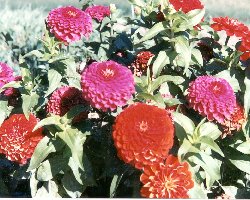Zinnias are one of the best cut flowers for bouquets. Their long stems make the great as gift bouquets to brighten up the house for a special occasion. Grow your own and you don't have to order from the florist.
| The many bright colors of zinnia blooms are chief attraction of this annual. They make great cut flowers and are usually fragrant.
As a child, the first flower bed I ever planted was of zinnia in its multitude of colors. They are easy to grow from seeds and are commonly available from garden centers in the spring. The taller varieties have blooms up to four inches across. The smaller varieties tend to have a multitude of smaller blooms. Almost any color except blue is available, even green. (A zinnia variety called Envy has large green blooms.) Some varieties are multicolored as well.
Remove the top bud to make the plant bushier, and remove old blooms once they start to turn brown. You can cut them off with clippers or scissors, or pinch the stem back to the topmost leaf. Give it some liquid fertilizer or manure tea once a month. This will help keep the plant blooming well all the way to the first frost.
In humid weather, zinnia sometime suffer from whitish or gray
discoloration on leaves due to a disease called powdery mildew that is difficult to cure. You can try to stop the spread of the disease by removing the infected plants. Rose bushes, verbena, and various other plants can also get powdery mildew. Try not to splatter soil onto the plant when you water to keep the disease organisms off the plant. If the mildew shows up, plant next year's zinnias in another location to avoid contagion from the soil. Zinnias can attract grasshoppers and aphids or plant lice. You can use a chemical spray containing malathion or try the organic method of using insecticidal soap to control insects. Infestations are usually not a major problem. The flowers attract bees and butterflies, one reason not to over use chemical sprays.
Zinnias make fine cut flowers because of their long straight stems and large flowers.
I grew and enjoyed them as a child and sometimes I saved their seeds for next year's garden. It is easy to do. Just let the blooms dry up at the end of the season in September. At the center of the dead flower, at the base of each petal, is the black seed attaching the petal to the central pod. Pluck some out after they are hard and dry. Put in an envelope in a cool dark spot. You can save old seed packages so that you can refer to the information when it is time to plant again.
Through the winter months you can dream of the zinnia colors that you will grow next year. |

|